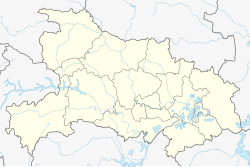Maojian, Shiyan
Maojian 茅箭区 | |
|---|---|
 Shiyan Railway Station | |
| Coordinates (Maojian government): 32°35′31″N 110°48′47″E / 32.592°N 110.813°E | |
| Country | People's Republic of China |
| Province | Hubei |
| Prefecture-level city | Shiyan |
| Seat | Wudang Road Subdistrict |
| Area | |
• Total | 578 km2 (223 sq mi) |
| Population (2020)[2] | |
• Total | 601,548 |
| • Density | 1,000/km2 (2,700/sq mi) |
| Time zone | UTC+8 (China Standard) |
| Postal code | 432012 |
| Website | maojian |
Maojian District (simplified Chinese: 茅箭区; traditional Chinese: 茅箭區; pinyin: Máojiàn Qū) is a district in the prefecture-level city of Shiyan, Hubei, China.[3] Maojian District spans an area of 578 square kilometers,[1] and is home to 601,548 permanent residents (huji population).[2] The district serves as the seat of government for the city of Shiyan.[4]
Geography
The district sits at the foot of the Wudang Mountains, and has an elevation ranging from 187 to 1,723 meters in height.[5]
Climate
Maojian District experiences a warm subtropical climate characterized with dry winters.[5] The district experiences an average annual temperature of 15.3 °C, an average of 246 days without frost, and an average annual precipitation totaling 884.9 millimeters.[5]
Administrative divisions
Maojian District is divided into four subdistricts, one town, and two townships.[6][7] The district's four subdistricts are Wudang Road Subdistrict, Eryan Subdistrict,Wuyan Subdistrict, and Bailang Subdistrict, respectively.[6][7] The district's sole town is Dachuan.[6][7] The district's two townships are Maota Township and Yuanyang Township.[6][7] The district government is seated in Wudang Road Subdistrict.[1]
Economy
Maojian District is the economic center of Shiyan, and is home to much of the city's industry, as well as the majority of its retail.[8] The district is home to a number of Dongfeng Motor's production facilities, which produce passenger vehicles, light commercial vehicles, heavy duty trucks, and various auto parts.[8]
The district has reported GDP of 6.95 billion Yuan in the first quarter of 2020, a 28.1% decrease from the previous quarter, likely attributed to the COVID-19 Pandemic in China.[9] Of this, 0.29% of the district's GDP came from the primary sector, 21.15% of the district's GDP came from the secondary sector, and 78.56% of the district's GDP came from the tertiary sector.[9]
References
- ^ a b c 茅箭区概况地图 (in Chinese). XZQH.org. 2014-07-22. Archived from the original on 2020-06-09. Retrieved 2020-06-09.
- ^ a b 人口民族 (in Chinese). Maojian District Government. 2019-09-26. Archived from the original on 2020-06-09. Retrieved 2020-06-09.
- ^ 茅箭区历史沿革 [Maojian District Historical Development] (in Simplified Chinese). XZQH.org. 22 July 2014. Retrieved 19 November 2018.
- ^ 十堰市概况地图 (in Chinese). XZQH.org. 2014-09-25. Archived from the original on 2020-06-09. Retrieved 2020-06-09.
- ^ a b c 自然地理 (in Chinese). Maojian District Government. 2019-09-26. Archived from the original on 2020-06-09. Retrieved 2020-06-09.
- ^ a b c d 行政区划 [Administrative Divisions] (in Simplified Chinese). Maojian District Government. 2019-09-26. Archived from the original on 2020-06-09. Retrieved 2020-06-09.
- ^ a b c d 2019年统计用区划代码和城乡划分代码:茅箭区 [2019 Statistical Area Numbers and Rural-Urban Area Numbers: Maojian District] (in Simplified Chinese). National Bureau of Statistics of the People's Republic of China. 2019. Archived from the original on 2020-06-09. Retrieved 2020-06-09.
- ^ a b 基本情况 (in Chinese). Maojian District Government. 2019-09-26. Archived from the original on 2020-06-09. Retrieved 2020-06-09.
- ^ a b 2020年4月统计月报 (in Chinese). Maojian District Government. 2020-05-28. Archived from the original on 2020-06-09. Retrieved 2020-06-09.

